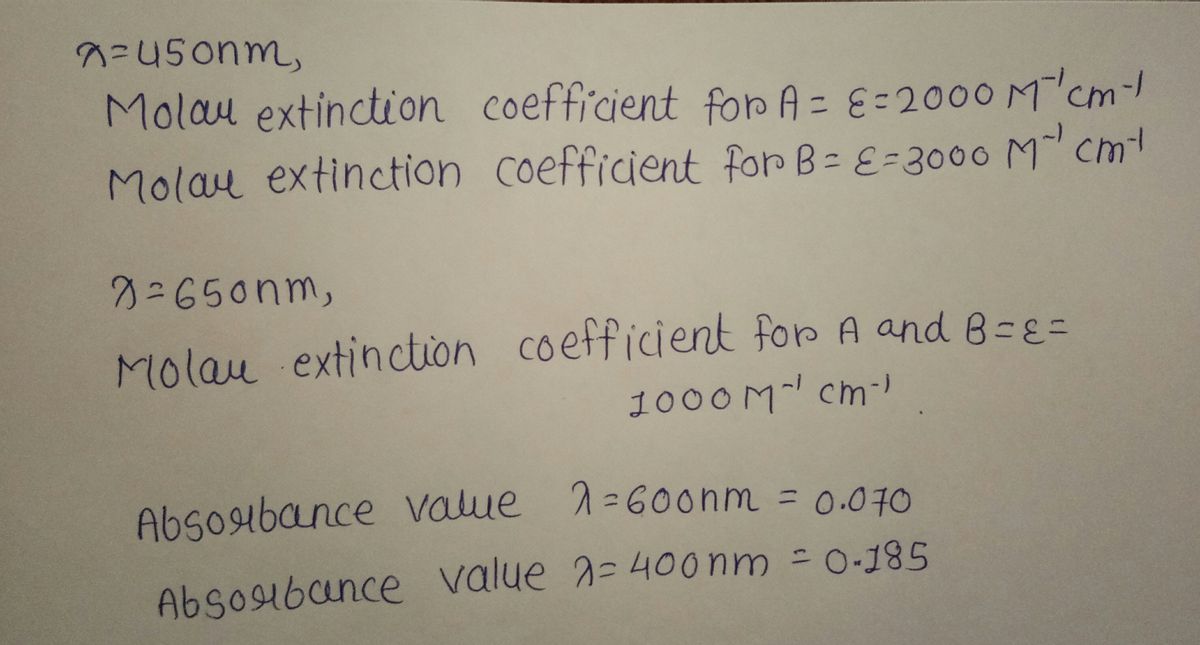The molar extinction coefficients for A and B at =450 nm are ɛ=2,000. and ɛ=3000. M cm'. At A=650 nm, the molar extinction coefficients are ɛ=1,000. for both compounds. If a sample containing both species had absorbance values at 2=600 nm are A=0.070 and at 1=400 nm are A=0.185, what concentrations of A and B are present in the unknown solution? Assume that the absorbances are additive and that the measurements were made using a 1-cm cuvette. Show your work.
The molar extinction coefficients for A and B at =450 nm are ɛ=2,000. and ɛ=3000. M cm'. At A=650 nm, the molar extinction coefficients are ɛ=1,000. for both compounds. If a sample containing both species had absorbance values at 2=600 nm are A=0.070 and at 1=400 nm are A=0.185, what concentrations of A and B are present in the unknown solution? Assume that the absorbances are additive and that the measurements were made using a 1-cm cuvette. Show your work.
Chemistry
10th Edition
ISBN:9781305957404
Author:Steven S. Zumdahl, Susan A. Zumdahl, Donald J. DeCoste
Publisher:Steven S. Zumdahl, Susan A. Zumdahl, Donald J. DeCoste
Chapter1: Chemical Foundations
Section: Chapter Questions
Problem 1RQ: Define and explain the differences between the following terms. a. law and theory b. theory and...
Related questions
Question
Please show all the calculations with steps and explanations

Transcribed Image Text:**Problem Statement:**
The molar extinction coefficients for A and B at \( \lambda = 450 \, \text{nm} \) are \( \varepsilon = 2,000 \, \text{M}^{-1}\text{cm}^{-1} \) and \( \varepsilon = 3,000 \, \text{M}^{-1}\text{cm}^{-1} \). At \( \lambda = 650 \, \text{nm} \), the molar extinction coefficients are \( \varepsilon = 1,000 \, \text{M}^{-1}\text{cm}^{-1} \) for both compounds. If a sample containing both species had absorbance values at \( \lambda = 600 \, \text{nm} \) of \( A = 0.070 \) and at \( \lambda = 400 \, \text{nm} \) are \( A = 0.185 \), what concentrations of A and B are present in the unknown solution? Assume that the absorbances are additive and that the measurements were made using a 1-cm cuvette. Show your work.
Expert Solution
Step 1

Step by step
Solved in 3 steps with 4 images

Recommended textbooks for you

Chemistry
Chemistry
ISBN:
9781305957404
Author:
Steven S. Zumdahl, Susan A. Zumdahl, Donald J. DeCoste
Publisher:
Cengage Learning

Chemistry
Chemistry
ISBN:
9781259911156
Author:
Raymond Chang Dr., Jason Overby Professor
Publisher:
McGraw-Hill Education

Principles of Instrumental Analysis
Chemistry
ISBN:
9781305577213
Author:
Douglas A. Skoog, F. James Holler, Stanley R. Crouch
Publisher:
Cengage Learning

Chemistry
Chemistry
ISBN:
9781305957404
Author:
Steven S. Zumdahl, Susan A. Zumdahl, Donald J. DeCoste
Publisher:
Cengage Learning

Chemistry
Chemistry
ISBN:
9781259911156
Author:
Raymond Chang Dr., Jason Overby Professor
Publisher:
McGraw-Hill Education

Principles of Instrumental Analysis
Chemistry
ISBN:
9781305577213
Author:
Douglas A. Skoog, F. James Holler, Stanley R. Crouch
Publisher:
Cengage Learning

Organic Chemistry
Chemistry
ISBN:
9780078021558
Author:
Janice Gorzynski Smith Dr.
Publisher:
McGraw-Hill Education

Chemistry: Principles and Reactions
Chemistry
ISBN:
9781305079373
Author:
William L. Masterton, Cecile N. Hurley
Publisher:
Cengage Learning

Elementary Principles of Chemical Processes, Bind…
Chemistry
ISBN:
9781118431221
Author:
Richard M. Felder, Ronald W. Rousseau, Lisa G. Bullard
Publisher:
WILEY